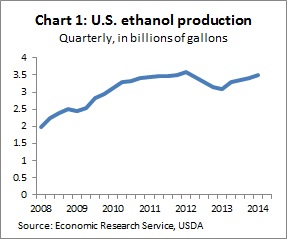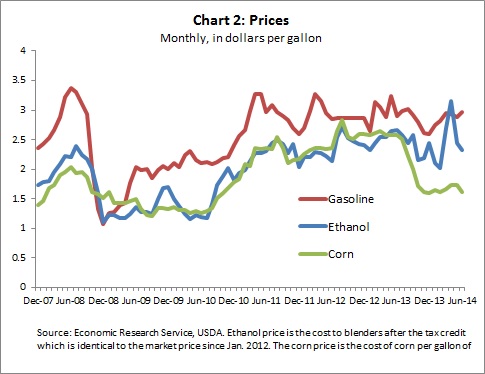Ethanol’s popularity has swung dramatically over the past decade. It went from being touted as the answer to oil dependency and a savior for rural economies to getting derided as a waste of corn that drove up the price of food while providing questionable environmental benefits. One criticism directed at ethanol was that it wouldn’t be as competitive an energy source if it didn’t benefit from hefty government subsidies.
The latter criticism got put to the test beginning in 2012. That was when the federal blenders’ tax credit, the primary subsidy to ethanol production, was discontinued after Congress opted not to renew it. And indeed, national production of ethanol peaked in late-2011 and went into decline after the credit expired (see Chart 1).

However, production has been on the increase during the last year, nearly returning to the pre-expiration peak over the three months from December 2013 through February 2014 (the USDA tracks quarterly ethanol production by marketing year, which goes from September through August).
The likely reason for this rebound is that, in spite of the end of the tax credit, other market conditions have turned favorable for ethanol producers. In particular, the price of corn used to produce ethanol has dropped sharply from its late-2012 peak (see Chart 2). The price of the fuel itself hasn’t dropped nearly as much as this input cost, pushing up profit margins for distillers, while the price of gas—a substitute—has remained elevated over the same period.
This all adds up to happy news for distillers, and the good times are likely to continue; the USDA forecasts corn prices to stay down this year and also projects that more corn will be used to produce ethanol than in any previous year.

Joe Mahon is a Minneapolis Fed regional outreach director. Joe’s primary responsibilities involve tracking several sectors of the Ninth District economy, including agriculture, manufacturing, energy, and mining.





